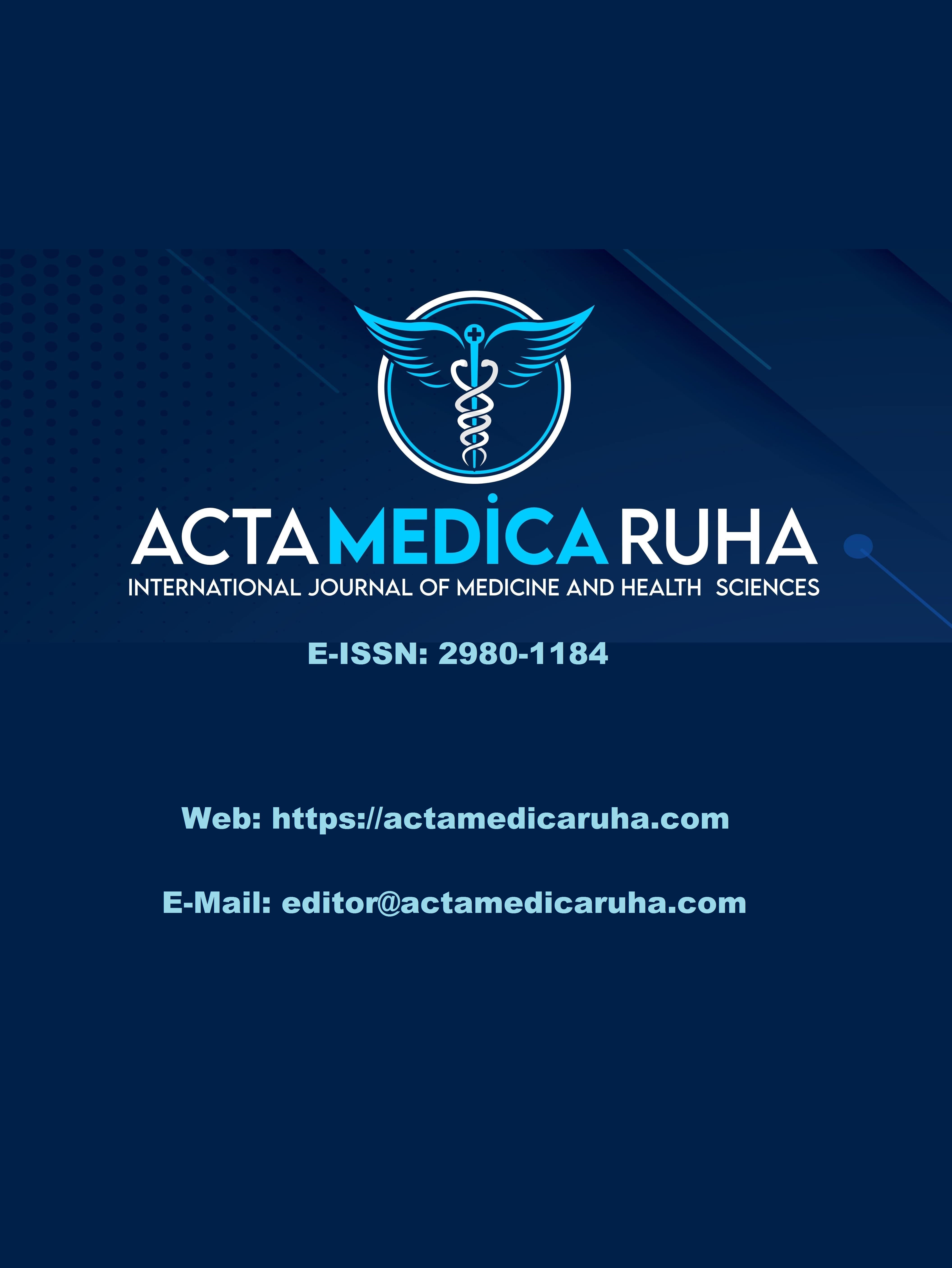Toxoplasma Gondii, Rubella Ve CMV Seroprevalansı: Beş Yıllık Sonuçların Değerlendirilmesi
Araştırma Makalesi
DOI:
https://doi.org/10.5281/zenodo.8320228Anahtar Kelimeler:
Toxoplasma Gondii, Rubella, CMV, SeroprevalansÖzet
Giriş: Toxoplasma gondii, insanlar da dahil olmak üzere hemen hemen tüm sıcakkanlı hayvanları enfekte eden ve en başarılı ökaryotik patojenlerden biri olarak kabul edilen bir protozoon parazittir. Dünya çapındaki insan popülasyonunun yaklaşık %30'u kronik olarak T. gondii ile enfektedir. İlk olarak 1962'de hücre kültüründen izole edilen kızamıkçık virüsü, tek sarmallı pozitif polariteli RNA genomu içerir. Kızamıkçık virüsü, Togaviridae familyasına aittir ve Rubivirüs cinsinin tek üyesidir. Kızamıkçık hastalığının veya sözde "Alman kızamığı" nın etken maddesidir. İnsan herpesvirüs ailesinin beşinci üyesi olan Sitomegalovirüs (CMV), klinik hastalığa neden olduğu bilinen en büyük virüslerden biridir. İnsan herpesvirüsleri 6A, 6B ve 7 ile birlikte beta-herpesvirüs alt ailesine ait çift sarmallı bir DNA virüsüdür.
Amaç: İntrauterin enfeksiyonlara neden olan ve benzer klinik tablolar oluşturan Toxoplasma gondii, Rubella, CMV ve Herpes Simplex virüsünün neden olduğu konjenital enfeksiyonlar kompleksine TORCH sendromu adı verilmektedir. Biz çalışmamızda Gaziantep Halk Sağlığı Laboratuvarında Ocak 2018 - Haziran 2023 tarihleri arasında Toxoplasma gondii, Rubella ve CMV seroprevalansını tespit etmeyi amaçladık.
Yöntem: Çalışmamızda 1 Ocak 2018 ve 13 Haziran 2023 tarihleri arasında, birinci basamak sağlık kuruluşlarına çeşitli nedenlerle başvuran ve Rubella, CMV ve Toksoplazma için IgM ve IgG antikor testleri istenilen hastalara ait sonuçlar, Gaziantep Halk Sağlığı Laboratuvarı bilgi yönetim sisteminden geriye dönük olarak incelenmiştir.
Bulgular: Toxoplazma IgG antikor testi yapılan olgu sayısı 155 615, pozitif saptanan olgu sayısı 66 925 (%43.00) olarak saptandı. Toxoplazma IgM antikor testi yapılan olgu sayısı 226 874, pozitif saptanan olgu sayısı 5869 (%2.58) olarak saptandı. Rubella IgG antikor testi yapılan olgu sayısı 150 261, pozitif saptanan olgu sayısı 136 773 (%91.02) olarak saptandı.Rubella IgM antikor testi yapılan olgu sayısı 218 384, pozitif saptanan olgu sayısı 1488 (%0.68) olarak saptandı. CMV IgG antikor testi yapılan olgu sayısı 148 071, pozitif saptanan olgu sayısı 147 101 (%99.34) olarak saptandı.CMV IgM antikor testi yapılan olgu sayısı 216 972, pozitif saptanan olgu sayısı 2278 (%1.04) olarak saptandı.
Sonuç: TORCH sendromunu oluşturan hastalıklar daha çok fetüs ve yenidoğanda konjenital enfeksiyonlar yaptıkları için dünyada ve ülkemizde genellikle gebelerde epidemiyolojik çalışmalar yapılmıştır. Bizim çalışmamızın ise genel populasyonda yapılması ve olgu sayısının yüksek olması nedeniyle bu konuda literatüre ek katkı sağlayacağını umuyoruz.
Referanslar
Liu Q, Singla LD, Zhou H. Vaccines against Toxoplasma gondii: status, challenges and future directions. Hum Vacc Immunother. 2012;8:1305–1308.
Moncada PA, Montoya JG. Toxoplasmosis in the fetus and newborn: an update on prevalence, diagnosis and treatment. Expert Rev Anti Infect Ther. 2012;10:815–828.
Dubey JP. The history of Toxoplasma gondii–the first 100 years. J Eukaryot Microbiol. 2008;55:467–475.
Paul M. Immunoglobulin G avidity in diagnosis of toxoplasmic lymphadenopathy and ocular toxoplasmosis. Clin Diagn Lab Immun. 1999;6:514–518.
Cuomo G, D'Abrosca V, Rizzo V, et al. Severe polymyositis due to Toxoplasma gondii in an adult immunocompetent patient: a case report and review of the literature. Infection. 2013;41:859–862.
Saadatnia G, Golkar M. A review on human toxoplasmosis. Scand J Infect Dis. 2012;44:805–814.
Hermanns B, Brunn A, Schwarz ER, et al. Fulminant toxoplasmosis in a heart transplant recipient. Pathol Res Pract. 2001;197:211–215.
Montoya JG, Liesenfeld O. Toxoplasmosis. Lancet. 2004;363:1965–1976.
Weller TH, Neva FA. Propagation in Tissue Culture of Cytopathic Agents from Patients with Rubella-Like Illness. Jama. 1963;183(10):243–247.
Frey TK. Molecular biology of rubella virus. Advances in Virus Research. 1994;44:69–160.
Battisti AJ, Yoder JD, Plevka P, et al. Cryo-electron tomography of rubella virus. Journal of Virology. 2012;86(20):11078–11085.
Alford CA, Jr, Neva FA, Weller TH. Virologic and Serologic Studies on Human Products of Conception after Maternal Rubella. The New England Journal of Medicine. 1964;271:1275–1281.
Winchester SA, Varga Z, Parmar D, et al. Persistent intraocular rubella infection in a patient with Fuchs' uveitis and congenital rubella syndrome. Journal of Clinical Microbiology. 2013;51(5):1622–1624.
Klemola E, Kääriäinen L. Cytomegalovirus as a possible cause of a disease resembling infectious mononucleosis. Br Med J. 1965;2:1099–1102.
Lanzieri TM, Kruszon-Moran D, Amin MM, et al. Seroprevalence of cytomegalovirus among children 1 to 5 years of age in the United States from the National Health and Nutrition Examination Survey of 2011 to 2012. Clin Vaccine Immunol. 2015;22:245–247.
Bate SL, Dollard SC, Cannon MJ. Cytomegalovirus seroprevalence in the United States: the national health and nutrition examination surveys, 1988–2004. Clin Infect Dis. 2010:1439–1447.
Escobar MR, Allison MJ, Dalton HP. Etiology and laboratory diagnosis of infectious mononucleosis: II. Cytomegalovirus (CMV) mononucleosis. Va Med Mon. (1918) 1970;97:191–192.
Plachter B, Sinzger C, Jahn G. Cell types involved in replication and distribution of human cytomegalovirus. Adv Virus Res. 1996;46:195–261.
Vauloup-Fellous C, Berth M, Heskia F, Dugua JM, Grangeot-Keros L. Re-evaluation of the VIDAS((R)) cytomegalovirus (CMV) IgG avidity assay: determination of new cut-off values based on the study of kinetics of CMV-IgG maturation. J Clin Virol. 2013;56:118–123.
Gulden Sonmez Tamer, Deyrim Dundar, Eray Caliskan. Seroprevalence of Toxoplasma gondii, rubella and cytomegalovirus among pregnant women in western region of Turkey. Clin Invest Med. 2009;2(1):E43-7.
Umut Safiye Şay Coşkun, Hatice Yılmaz Doğru. Gebelerde Toxoplasma gondii ve Rubella Seroprevalansı: İki Yıllık Değerlendirme. F.Ü.Sağ.Bil.Tıp.Derg. 2018; 32 (3):119–122.
Pappas G, Roussos N, Falagas ME. Toxoplasmosis snapshots: global status of Toxoplasma gondii seroprevalence and implications for pregnancy and congenital toxoplasmosis. Int. J. Parasitol. 2009:39:1385–1394.
Ertug S, Okyay P, Turkmen M, Yuksel H. Seroprevalence and risk factors for Toxoplasma infection among pregnant women in Aydin province, Turkey. BMC Public Health. 2005; 5:66.
Jones JL, Dubey JP. Waterborne toxoplasmosis—recent developments. Exp. Parasitol. 2010; 124:10–25.
Bahia-Oliveira LM, et al. Highly endemic, waterborne toxoplasmosis in north Rio de Janeiro state, Brazil. Emerg. Infect. Dis. 2003; 9:55–62.
Hotez PJ. Neglected infections of poverty in the United States of America. PLoS Negl. Trop. Dis. 2008;2:e256.
Jones JL, Kruszon-Moran D, Sanders-Lewis K, Wilson M. Toxoplasma gondii infection in the United States, 1999-2004, decline from the prior decade. Am. J. Trop. Med. Hyg. 2007;77:405–410.
Villena I, et al. 2010. Congenital toxoplasmosis in France in 2007: first results from a national surveillance system. Euro Surveill. 2007:15(25):pii=19600.
Hofhuis A, et al. Decreased prevalence and age-specific risk factors for Toxoplasma gondii IgG antibodies in The Netherlands between 1995/1996 and 2006/2007. Epidemiol. Infect. 2011;139:530–538.
Bouthry E, Picone O, Hamdi G, et al. Rubella and pregnancy: diagnosis, management and outcomes. Prenat Diagn. 2014;34:1246-53.
Kimberlin DW, Brady MT, Jackson MA, et al editors. Red Book: 2018 Report of the Committee on Infectious Diseases. 31st ed. Itasca: American Academy of Pediatrics; 2018: 705-11.
Drutz JE. Rubella. Pediatr Rev. 2010;31:129-30.
Tyor W, Harrison T. Mumps and rubella. Handb Clin Neurol. 2014;123:591-600.
Duszak RS. Congenital rubella syndrome—major review. Optometry. 2009;80:36-43.
Edwards MS. Rubella. Available from: https://www.uptodate.com/contents/rubella. Accessed 5 Dec 2018.
Riley LE. Rubella in pregnancy. Available from: https://www.uptodate.com/contents/rubella-in-pregnancy. Accessed 10 Dec 2018.
Kirby T. Rubella is eliminated from the Americas. Lancet Infect Dis. 2015;15:768-9.
Fang J, Agrawal A, Gowtham S, et al. Case report: congenital rubella syndrome: a rare but persistent concern in the United States. J Perinatol. 2013;33:899-902.
Shukla S, Maraqa NF. Congenital rubella. StatPearls. Available from: https://www.ncbi.nlm.nih.gov/books/NBK507879/. Accessed 10 Jan 2019.
Rubella vaccines: WHO position paper. Wkly Epidemiol Rec. 2011;86:301-16.
Martínez-Quintana E, Castillo-Solórzano C, Torner N, et al. Congenital rubella syndrome: a matter of concern. Rev Panam Salud Publica. 2015;37:179-186.
Chang C, Ma H, Liang W, et al. Rubella outbreak and outbreak management in a school setting, China, 2014. Hum Vaccin Immunother. 2017;13:772-775.
Lambert N, Strebel P, Orenstein W, et al. Rubella. Lancet. 2015;385:2297-307.
Hackett DW. Japan’s rubella outbreak reaches 2,186 cases. 29 Nov 2018. Available from: https://www.precisionvaccinations.com/travel-alert-level-2-remains-active-regarding-japan%E2%80%99s-rubella-outbreak. Accessed 14 Mar 2019.
Hong Kong SAR Government. Press release. Public and travellers urged to guard against infectious diseases during Lunar New Year holiday. Available from: https://www.info.gov.hk/gia/general/201901/25/P2019012500443.htm. Accessed 10 Nov 2019.
Tyor W, Harrison T. Mumps and rubella. Handb Clin Neurol. 2014;123:591-600.
Sadlier C, Carr A, Bergin C. High levels of susceptibility to measles, mumps and rubella (MMR) in HIV-infected individuals in Ireland. J Infect. 2016;73:84-6.
Zuhair M, Smit GSA, Wallis G, et al. Estimation of the worldwide seroprevalence of cytomegalovirus: a systematic review and meta-analysis. Rev Med Virol. 2019;29(3):e2034.
Bate SL, Dollard SC, Cannon MJ. Cytomegalovirus seroprevalence in the United States: the national health and nutrition examination surveys, 1988–2004. Clin Infect Dis. 2010;50:1439–1447.
Lanzieri TM, Kruszon-Moran D, Amin MM, et al. Seroprevalence of cytomegalovirus among children 1 to 5 years of age in the United States from the National Health and Nutrition Examination Survey of 2011 to 2012. Clin Vaccine Immunol. 2015;22:245–247.
Kabani N, Ross SA.Congenital Cytomegalovirus Infection.J Infect Dis. 2020 Mar 5;221:S9-S14.
Escobar MR, Allison MJ, Dalton HP. Etiology and laboratory diagnosis of infectious mononucleosis: II. Cytomegalovirus (CMV) mononucleosis. Va Med Mon. 1970;97:191–192.
Plachter B, Sinzger C, Jahn G. Cell types involved in replication and distribution of human cytomegalovirus. Adv Virus Res. 1996;46:195–261.
Vauloup-Fellous C, Berth M, Heskia F, et al. Re-evaluation of the VIDAS((R)) cytomegalovirus (CMV) IgG avidity assay: determination of new cut-off values based on the study of kinetics of CMV-IgG maturation. J Clin Virol. 2013;56:118–123.
Cannon MJ, Schmid DS, Hyde TB. Review of cytomegalovirus seroprevalence and demographic characteristics associated with infection. Rev Med Virol. 2010;20(4):202–213.
Toriyabe K, Morikawa F, Minematsu T, et al. Anti-cytomegalovirus immunoglobulin M titer for congenital infection in first-trimester pregnancy with primary infection: a multicenter prospective cohort study. J Perinatol. 2017;37(12):1272–1277.
Siennicka J, Dunal-Szcepaniak M, Trzcińska A, et al. High seroprevalence of CMV among women of childbearing age implicates high burden of congenital cytomegalovirus infection in Poland. Pol J Microbiol. 2017;65(4):425–432.
Antona D, Lepoutre A, Fonteneau L, et al. Seroprevalence of cytomegalovirus infection in France in 2010. Epidemiol Infect. 2017;145(7):1471–1478.
Barlinn R, Vainio K, Samdal HH, et al. Susceptibility to cytomegalovirus, parvovirus B19 and age-dependent differences in levels of rubella antibodies among pregnant women. J Med Virol. 2014;86(5):820–826.
Gorun F, Motoi S, Malita D, et al. Cytomegalovirus seroprevalence in pregnant women in the western region of Romania: a large-scale study. Exp Ther Med. 2020;20(3):2439–2443.
Laboratory Testing. https://www.cdc.gov/cmv/clinical/lab-tests.html.Accessed 10 May 2023.
Antona D, Lepoutre A, Fonteneau L, et al. Seroprevalence of cytomegalovirus infection in France in 2010. Epidemiol Infect. 2017;145(7):1471–1478.
Styles JN, Converse RR, Griffin SM, et al. Human cytomegalovirus infections are associated with elevated biomarkers of vascular injury. Front Cell Infect Microbiol. 2020;10:334.
Arapović J, Rajič B, Pati S, et al. Cytomegalovirus seroprevalence and birth prevalence of congenital CMV infection in Bosnia and Herzegovina: a single-center experience. Pediatr Infect Dis J. 2020;39(2):140–144.
Barlinn R, Vainio K, Samdal HH, et al. Susceptibility to cytomegalovirus, parvovirus B19 and age-dependent differences in levels of rubella antibodies among pregnant women. J Med Virol. 2014;86(5):820–826.
Alvarado-Esquivel C, Sandoval-Carrillo AA, Vazquez-Alaniz F, et al. Lack of association between cytomegalovirus infection and hypertensive disorders in pregnancy: a case-control study in Durango, Mexico. Eur J Microbiol Immunol (Bp). 2017;7(3):229–233.
Alvarado-Esquivel C, Terrones-Saldivar MDC, Hernandez-Tinoco J, et al. Seroepidemiology of cytomegalovirus infection in pregnant women in the Central Mexican City of Aguascalientes. J Clin Med Res. 2018;10(4):337–344.
Dollard SC, Staras SA, Amin MM, et al. National prevalence estimates for cytomegalovirus IgM and IgG avidity and association between high IgM antibody titer and low IgG avidity. Clin Vaccine Immunol. 2011;18(11):1895–1899.
Lamarre V, Gilbert NL, Rousseau C, et al. Seroconversion for cytomegalovirus infection in a cohort of pregnant women in Québec, 2010–2013. Epidemiol Infect. 2016;144(8):1701–1709.
Wujcicka W, Gaj Z, Wilczyński J, et al. Impact of socioeconomic risk factors on the seroprevalence of cytomegalovirus infections in a cohort of pregnant Polish women between 2010 and 2011. Eur J Clin Microbiol Infect Dis. 2014;33(11):1951–1958.
Firth C, Harrison R, Ritchie S, et al. Cytomegalovirus infection is associated with an increase in systolic blood pressure in older individuals. QJM. 2016;109(9):595–600.
González-Quijada S, Mora-Simón MJ, Martin-Ezquerro A. Association between serological evidence of past Coxiella burnetii infection and atherosclerotic cardiovascular disease in elderly patients. Clin Microbiol Infect. 2014;20(9):873–878.
Lamarre V, Gilbert NL, Rousseau C, et al. Seroconversion for cytomegalovirus infection in a cohort of pregnant women in Québec, 2010–2013. Epidemiol Infect. 2016;144(8):1701–1709.
Vilibic-Cavlek T, Kolaric B, Beader N, et al. Seroepidemiology of cytomegalovirus infections in Croatia. Wien Klin Wochenschr. 2017;129(3–4):129–135.
Takao M, Yoshioka N, Hagiya H, et al. Risk for the occupational infection by cytomegalovirus among health-care workers. J Infect Chemother. 2020;26(7):681–684.
Takemoto K, Nishimura N, Kozawa K, et al. Time-series analysis comparing the prevalence of antibodies against nine viral species found in umbilical cord blood in Japan. Jpn J Infect Dis. 2016;69(4):314–318.
İndir
Yayınlanmış
Nasıl Atıf Yapılır
Sayı
Bölüm
Lisans
Telif Hakkı (c) 2023 Acta Medica Ruha

Bu çalışma Creative Commons Attribution 4.0 International License ile lisanslanmıştır.









